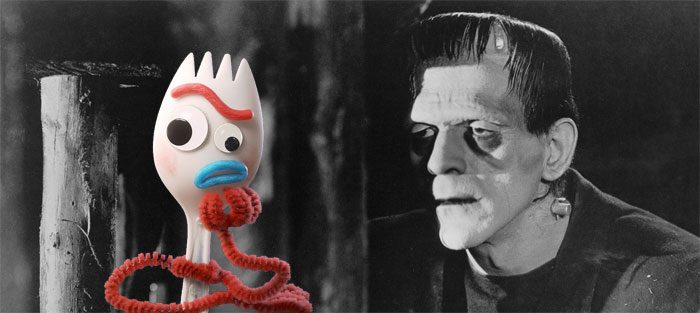
(Welcome to Classically Contemporary, a series where we explore the ways in which new releases echo classic Hollywood or how classic Hollywood continues to influence modern filmmaking.)
It’s hard to believe we’re still talking about Toy Story movies in 2019 and yet we are. The latest installment, Toy Story 4, charts the (presumably) final pairing between the heroes that started this series: cowboy doll Woody (voiced by Tom Hanks) and space ranger Buzz Lightyear (voiced by Tim Allen). Toy Story 4 follows Woody as he tries to Forky (voiced by Tony Hale), the new favorite toy of owner Bonnie, back to the family RV. Along the way Woody stumbles upon an old friend, Bo Peep (voiced by Annie Potts) and new villains.
The Toy Story features have all possessed random bits of classic film references, but Toy Story 4 discusses topics steeped in the history of classic cinema, particularly horror. So let’s dive into the classic world to better understand Toy Story 4!
Spoilers for Toy Story 4 ahead.
Gabby Gabby, Chatty Cathy, and Talky Tina
Woody’s attempts to reunite Forky with Bonnie see him stumbling upon an old antique store overseen by the elegant talking doll, Gabby Gabby (voiced by Christina Hendricks). Almost immediately comparisons are drawn to other talking dolls throughout popular culture. An immediate point of reference is Chatty Cathy, a popular pull-string talking doll that was a hit with consumers from 1959 to 1965. Toy Story has always made reference to toy trends – Barbie’s spiel in Toy Story 2 about the lack of Buzz Lightyear dolls to meet demand is a prime example – so it’s understandable that Chatty Cathy would eventually manifest.
But when Woody realizes that Gabby Gabby plans to cannibalize him for his voicebox she immediately segues into being reminiscent of the multitude of evil dolls that have existed, most notably Talky Tina. In 1963, itself capitalizing on the popularity of Chatty Cathy, The Twilight Zone aired the episode “Living Doll,” wherein a bad-hearted man (played by Telly Savalas) goes head-to-head with a conniving, yet cute, doll named Talky Tina. Though Tina’s plans soon turn murderous, she is incredibly similar to Gabby Gabby. Both have cultivated a polished appearance of wholesomeness that hides darker intentions; Gabby and Tina both rock pigtails.
Body Swaps and the Sense of Ownership
Gabby Gabby’s goal is to cut out Woody’s voicebox in order to fix her own. Mad scientists hoping to swap body parts have been common in horror, most iconically in the 1962 feature, The Brain That Wouldn’t Die. In that infamous bomb, a doctor’s fiance is decapitated in a car accident. Thankfully he’s a doctor who specializes in transplants and thus keeps the woman’s head alive while he looks for a new body.
The Toy Story franchise has never explicitly discussed what creates life in a toy. When Mr. Potato Head (Don Rickles) escapes from Sunnyside day care’s sandbox in Toy Story 3, he transports his facial parts onto a tortilla, which seems to transfer his consciousness. The same questions pop up with regards to Forky, who comes to life through Bonnie wrapping a pipe cleaner and sticking googly eyes onto a spork. This, again, conjures up images of the infamous transplant feature. Doctors assume a person’s body parts can be thrown onto a new person in cinema which, like Mr. Potato Head, ends up devolving into the belief that a person’s parts will always hold elements of their identity.
Take the 1935 horror feature Mad Love. Peter Lorre plays a legendary doctor who transplants a convict’s hands onto those of a concert pianist who finds his own crushed in an accident. Unfortunately, the pianist realizes something is different as his hands take on a life of their own, throwing knives much in the same way as their previous owner did. 1946’s The Beast With Five Fingers, also starring Peter Lorre, would trod similar territory. Hands and eyes have been popular in this genre, mainly because of their autonomy in the body (hands) and their highly personal identifying characteristics (eyes).
Man, Monster, and Universal Horror
And yet Bonnie’s power to create sentient creatures also holds commonalities with Universal’s popular monster movies, each focusing on the interplay between man and God, and the creation of a monster. Forky himself is reminiscent of Frankenstein’s monster, a simple character who needs to be taught about life and friendship (and how it might be the same as trash). Like 1935’s The Bride of Frankenstein, Forky comes to understand the role of family and individuality, and in the end gets his own “bride” in the form of a sentient knife named Karen Beverly.
Someone watched a lot of horror films while making Toy Story 4 (let’s not forget that Shining musical cue!), and it makes sense why. Horror has always shown our own fears about being alive and accepting our mortality. Man’s desire to play God or find ways of creating a new person out of someone else have made us examine how science and religion are interwoven. It’s also just great fun to watch a bunch of toys play out themes that have scared us for generations.
The post ‘Toy Story 4’ Has More in Common With Classic Horror Movies Than You May Realize appeared first on /Film.
from /Film http://bit.ly/2Yj2r3S
via IFTTT
Comments
Post a Comment